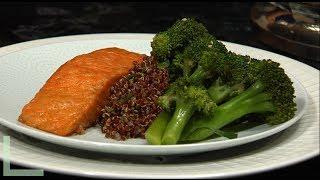How to Lose Weight After Cancer Treatment | Dana-Farber Cancer Institute

For more information, recipes, and tips, and to watch more videos on Eating Well During Cancer, visit http://www.dana-farber.org/eatingwell.
It's not uncommon to gain weight during or after cancer treatment. Weight gain may be a result of a combination of factors, including disease- or treatment-induced hormonal effects or changes. But unwanted weight gain can be managed, and even reversed, by following some simple, healthy eating and activity guidelines outlined here by Dana-Farber nutritionist Stacy Kennedy.
Transcription:
I’m Stacy Kennedy, a nutrition specialist for Dana-Farber Cancer Institute in Boston. Welcome to Eating Well During Cancer. Today I’d like to talk with you about maintaining a healthy weight during and after cancer treatment, and specifically how to manage unwanted weight gain.
It is not uncommon to actually gain excessive or unwanted weight during certain types of cancer treatment. For example, we see this with some types of breast cancer, where research shows a woman may gain in one year the amount of body fat she would typically gain over the course of ten years. Sometimes men going through prostate cancer treatment or men or women going through treatment for colon cancer may also experience unwanted weight gain.
It can be like a perfect storm of things happening. You may be a little bit less active, because you're feeling fatigued. Food choices might be altered, either because of symptom management or eating more comfort foods for coping. And then there’s aspects of the disease itself or the treatment that can all come together and set the stage for gaining some extra weight.
But don’t worry—this extra weight can come off by following some simple, healthy eating and activity guidelines. When it comes to healthy eating, following a schedule, where you're not skipping any meals and snacks and you're eating through the day, can be a big help. On top of that, choosing healthy foods in a combination or proportion to set you up for success is another great way to manage this weight gain.
For example, if we take a look at this plate here, we’ll see that we have half of our plate as vegetables—we’ve got some nice, delicious broccoli. And then we have a quarter of our plate as a whole grain—our example here today is quinoa. Now, quinoa is also high in fiber, which can help manage hunger. It’s also high in iron, which is important for a healthy body, and also high in protein, which can also—like the fiber—help with hunger. Beyond our quarter quinoa, we’ve got another quarter of our plate as a healthy, lean protein. Our example today is wild salmon.
This combination can help you to feel full and prevent overeating, while at the same time nourishing your body with a lot of immune-supporting nutrients, which can also help to manage hunger as well.
So, for more recipes and great tips for maintaining a healthy weigh, I encourage you to visit our website or download our free app. On behalf of Dana-Farber, I’m Stacy Kennedy.